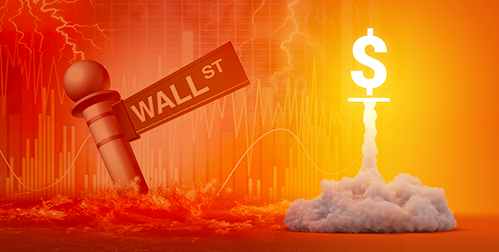Dollar Surges on Back of Record Interest Rate Hikes
For the first time since 2002, the US dollar hit 1:1 parity against the Euro. If you’re vacationing in Paris this summer, that’s great. For many others, it is a problem.1
The US dollar is the world’s most important currency. It is one of about 90 percent of all foreign exchange transactions. The dollar accounted for $6 trillion in daily activity before the pandemic.
And now, it is 50% higher than where it stood a decade ago. The US dollar has risen more than 20% since the beginning of 2021. 2
The dollar often rises in times of turmoil because investors consider it to be relatively stable. But now, analysts at Bank of America think that more than half the rise in the dollar this year is due to the Federal Reserve.3 The Fed has been aggressively hiking interest rates to fight inflation. They have been raising rates faster and harder than most other major central banks. Higher interest rates attract more investors looking for a return. As money pours in, the value of the dollar climbs even higher.
The main measure of the dollar’s strength is by comparing it against a basket of currencies from major trading partners like Japan and the eurozone. By that measure, the dollar is the strongest it’s been in 20 years.
What a Strong Dollar Means
A strong dollar means you’ll get more bang for your buck if you are travelling abroad. That is because the dollar is worth more than foreign currencies. A stronger dollar can also reduce oil prices. Since oil is priced in dollars, a stronger dollar buys much more oil.
The Federal Reserve’s goal of lowering inflation also benefits from the stronger dollar. A stronger dollar means lower prices on imports. Lower prices result in a lower inflation rate. Import prices, excluding fuel, contribute to half the increase in consumer prices. Fed signals that faster and steeper rate hikes are coming could strengthen the dollar even more.
Not everyone benefits from a record strong dollar. The script flips for non-US countries. Their weaker currencies mean higher costs for imports, especially oil.
Multinational US companies are also hurt by a rising dollar. Their goods become more expensive abroad. And in turn, sales are reduced. Factory towns in the US are likely to be hurt by depressed exports. American multinational companies take an extra hit when they convert profit from foreign sales back into dollars. Microsoft and Salesforce have already warned that the dollar’s surge would shrink profits.
Credit Suisse says that on average, an 8%-10% jump in the dollar causes US company profits to drop by 1%. Ben Laidler, global markets strategist at eToro, estimates that the rise in the dollar will shave 5 percent off the earnings growth of S&P 500 companies this year, or roughly $100 billion.4 Retirement portfolios will take an extra hit on top of the damage being caused by skyrocketing inflation.
Many companies and governments abroad borrow in dollars. And the dollar’s strength is a big problem for them. This is particularly true for poorer countries who took out loans in dollars instead of riskier local currencies. A rising dollar means the value of their debt is increasing. Debt-ridden countries will struggle to pay creditors as their own currencies drop against the dollar.
An unchecked strong dollar can result in a so called ‘doom loop’. The rising dollar increases the debt of another country and reduces the value of its exports. This reduces their currency and strengthens the dollar. Which just perpetuates the cycle more strongly until, ultimately, the foreign economy collapses. And in an interconnected world, negative effects abroad lead to negative effects at home.
At the moment, the surging dollar is keeping a lid on rising gold prices. Once the dollar peaks, experts predict gold prices could break out to new heights as demand for gold continues to swell as a hedge against inflation and recession. Now is a tremendous buying opportunity for gold. A Gold IRA could be the ideal vehicle to protect your assets against economic turmoil. Contact us to learn more today.







